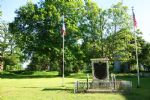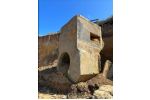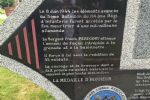Pointe du Hoc
- 85
- See on map
The pointe du Hoc was the scene of one of the operations of the Allied landings in Normandy on June 6, 1944. Situated between the beaches ofUtah Beach (to the west) and Omaha (to the east), the point had been fortified by the Germans (WN 751) and, according to Allied aerial reconnaissance, was equipped with heavy artillery whose range threatened both nearby beaches. It was deemed vital to the success of the landing that the artillery pieces be put out of action as quickly as possible. This mission was entrusted to the American 2nd Ranger Battalion, which succeeded in taking control of the site at the cost of heavy losses. Subsequently, the artillery pieces were revealed to have been moved by the Germans shortly beforehand and installed 1.3 km inland.
Prior to the landing of the 2nd Ranger Battalion scheduled for 6:30 a.m. on June 6, the Allied air force and navy had to bomb the Pointe du Hoc in order to neutralize the existing garrison of 125 German infantrymen and 80 German artillerymen.
To this end, on April 15, 1944, a powerful formation of Allied bombers from the land had flown over the Pointe du Hoc in three successive waves. The first bombs hit the large Guelinel farmhouse, now occupied only by the Germans, the Guelinel family having evacuated earlier. All the buildings were destroyed, including the barracks of the canteen built as an annex, as well as the stables and most of the horses used to pull the gun batteries.
According to German soldiers (Benno Müller, Emil Kaufman), in the course of this action two cribs were destroyed, and three of the six long-tube guns were severely damaged or rendered unusable. On the night of April 25 to 26 the intact guns were moved inland, 1,300 meters upstream, to a sunken road where they were ready to fire. To give the lie to future Allied reconnaissance flights, the battery commander had dummy guns and telegraph poles hastily erected in the unoccupied hollows. From that date onwards, the Todt organization stopped all new construction on the site, which was considered to be at risk3. The final D-Day bombardment took place on June 4, with 85 Douglas A-20 Havoc aircraft dropping almost 100 tons of bombs on the Pointe. The result was deemed satisfactory.
Then it was the heavy bombers of Operation Flashlamp, 35 Boeing B-17s, who pounded the site again on the morning of June 5, again dropping 100 tons of bombs, destroying a cannon and an ammunition bunker. Barely damaging, despite direct hits, three bomb-proof bunkers where personnel were stationed. This despite the materials used, notably high-explosive 500-pound bombs which were insufficient to pierce the shelters designed to withstand 1,000-pound bombs. Before D-Day itself, some 380 tons of bombs were dropped on the Pointe du Hoc.
At 4:30 a.m., ten LCAs (Landing Craft Assault) and four DUKWs had to be launched. Two of the DUKWs are each carrying a 33-meter-high fireman's ladder borrowed from the London Fire Brigade, while the LCAs are equipped with rocket launchers that will send ropes and rope ladders to the top of the cliff, as well as extendible ladders that will be assembled on site. At 6:30 a.m., James Earl Rudder's 225 men are to land on the beach and then climb the cliff to destroy the German artillery.
Companies E and F are to land to the east of the point, while Company D will land to the west.
Once the area is under control, they must fire a flare signifying the success of their mission in order to receive reinforcements (the 225 rangers of the 5th Battalion), while waiting to be joined by the American 116th Infantry Regiment disembarking at Omaha Beach. If by 7:00 a.m. no rockets had been fired, their mission having been deemed to have failed, the reinforcements would be diverted to Omaha Beach in Sector Charlie.
The preliminary naval bombardment began at 5:50 a.m., fired by the USS Texas, USS Satterlee and HMS Talybont, followed by a wave of 19 Martin B-26 Marauders from the 9th Air Force.
The operation began with the loss ofLCA 860 shortly after launching; in this boat was the commander of D Company, Captain Slater; he would join his comrades on June 9.Because of the current and smoke from the bombardment, the barges were deported to Pointe de la Percée two kilometers east of the planned landing site. This navigational error resulted in a forty-minute delay and the loss of a DUKW.
The Ranger battalion landed at 7:10 a.m. at the planned landing place. With no flares fired by 7:00 a.m., the planned reinforcements were deployed to Omaha Beach. The delay on the part of the rangers deprived them of the element of surprise, but the attack went relatively smoothly, thanks in particular to supporting fire from Allied destroyers.
Once the cliff had been climbed, the rangers took the German bunkers and discovered that the original 6 artillery pieces, French 155 mm GPF model 1917 guns, had been moved and replaced by wooden pylons.
By 8 am, the coastal road was under ranger control. Around 9 a.m., two rangers scouting inland discovered the artillery pieces, completely defenseless, and destroyed them with their incendiary grenades.
With reinforcements diverted to Omaha Beach, the 2nd Ranger Battalion found itself isolated.
In the afternoon, Lieutenant-Colonel Rudder sent the message "Are at Pointe-du-Hoc - mission accomplished - ammunition and reinforcements needed - many casualties" to the USS Satterlee who replied "no reinforcements available - all rangers deployed". The only reinforcements the 2nd Battalion rangers received were the survivors of Company A of the 5th Ranger Battalion who had landed at Omaha Beach. These reinforcements brought the 2nd Ranger Battalion up to around 85 men.
The rangers' situation was critical, and they came under heavy attack during the night from a company of the 352nd Infantry Division's 914.IR. At around 3 a.m., Company D covering the western flank was overwhelmed, and twenty rangers under Sergeant Petty stayed back to allow fifty of their comrades to fall back, and were taken prisoner.
On the morning of June 7, only 90 men were still fit to fight.
On the afternoon of June 7, a relief force consisting of elements of the 5th Ranger Battalion, the 116th Infantry and tanks from the 743rd Battalion finally arrived.
It wasn't until the morning of June 8 that American soldiers pushed the Germans back and took the village of Saint-Pierre-du-Mont, the closest village to the point, 1.5 km to the southeast.
Source Wikipedia


















